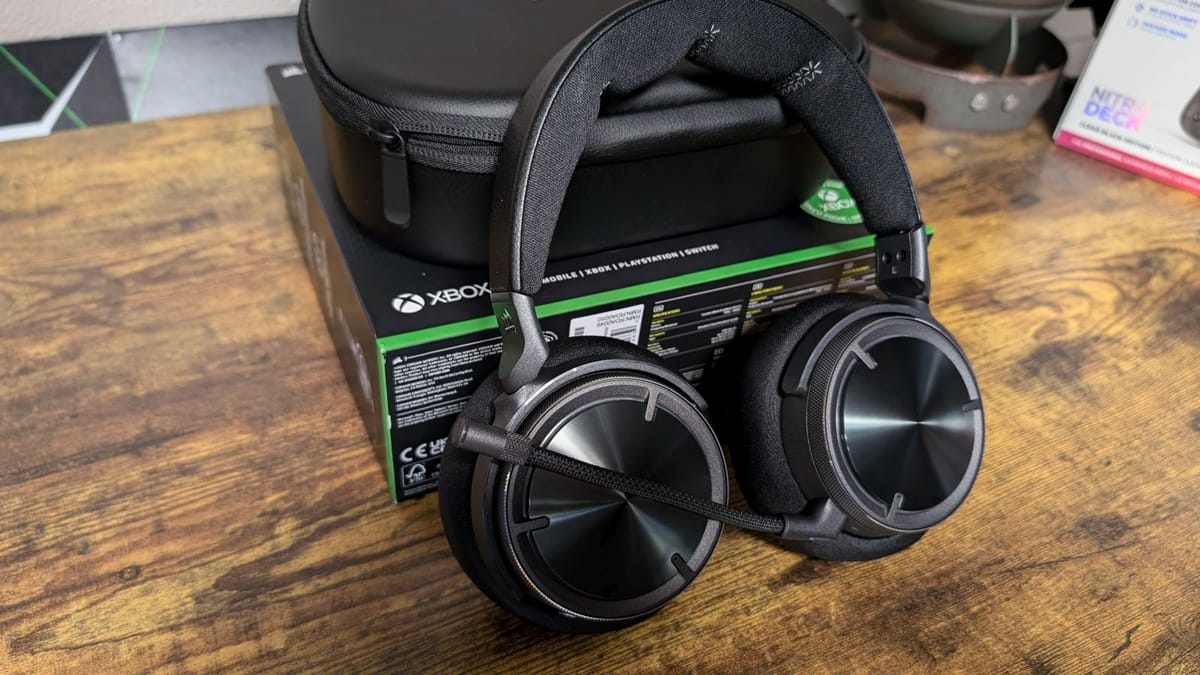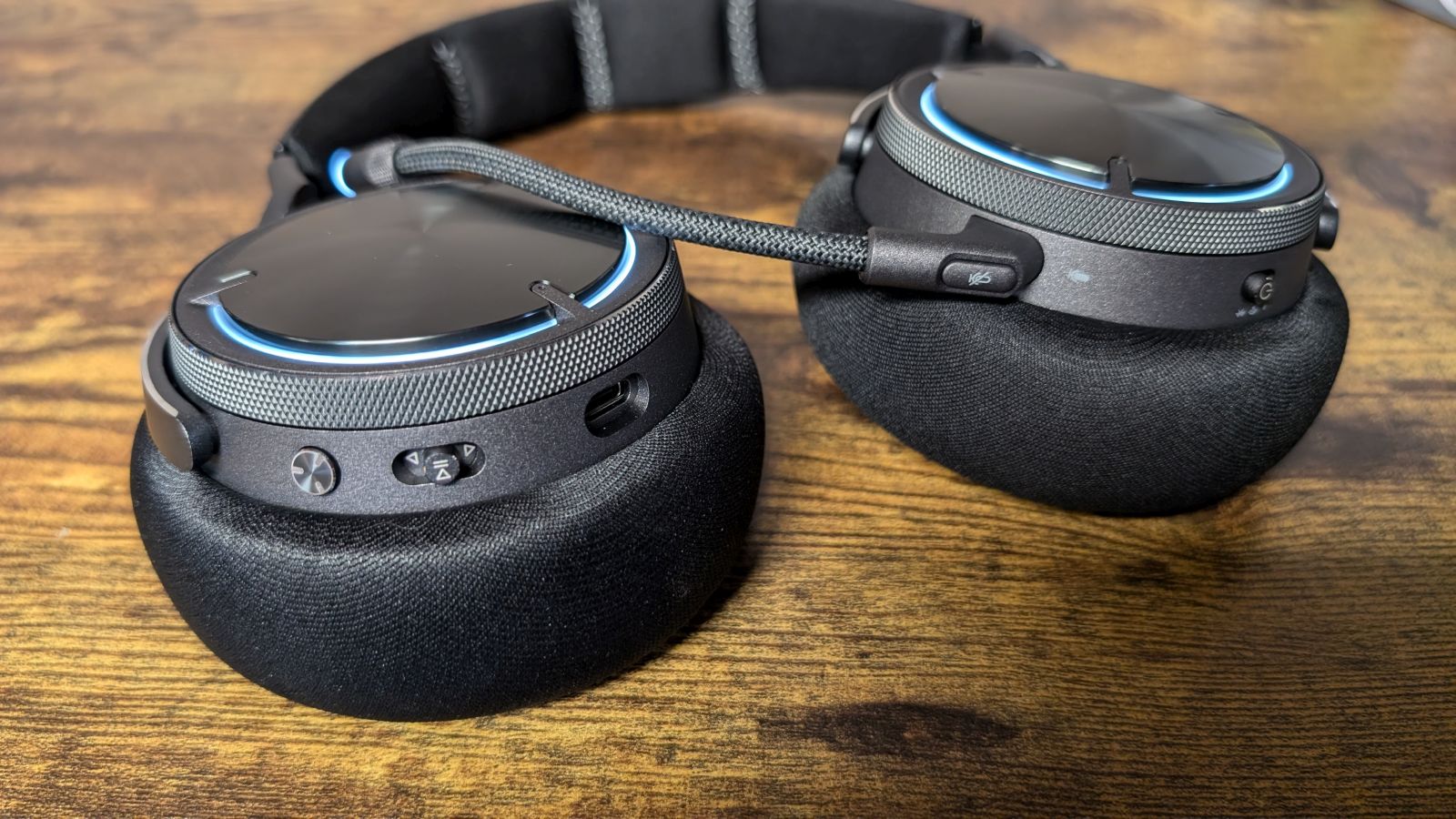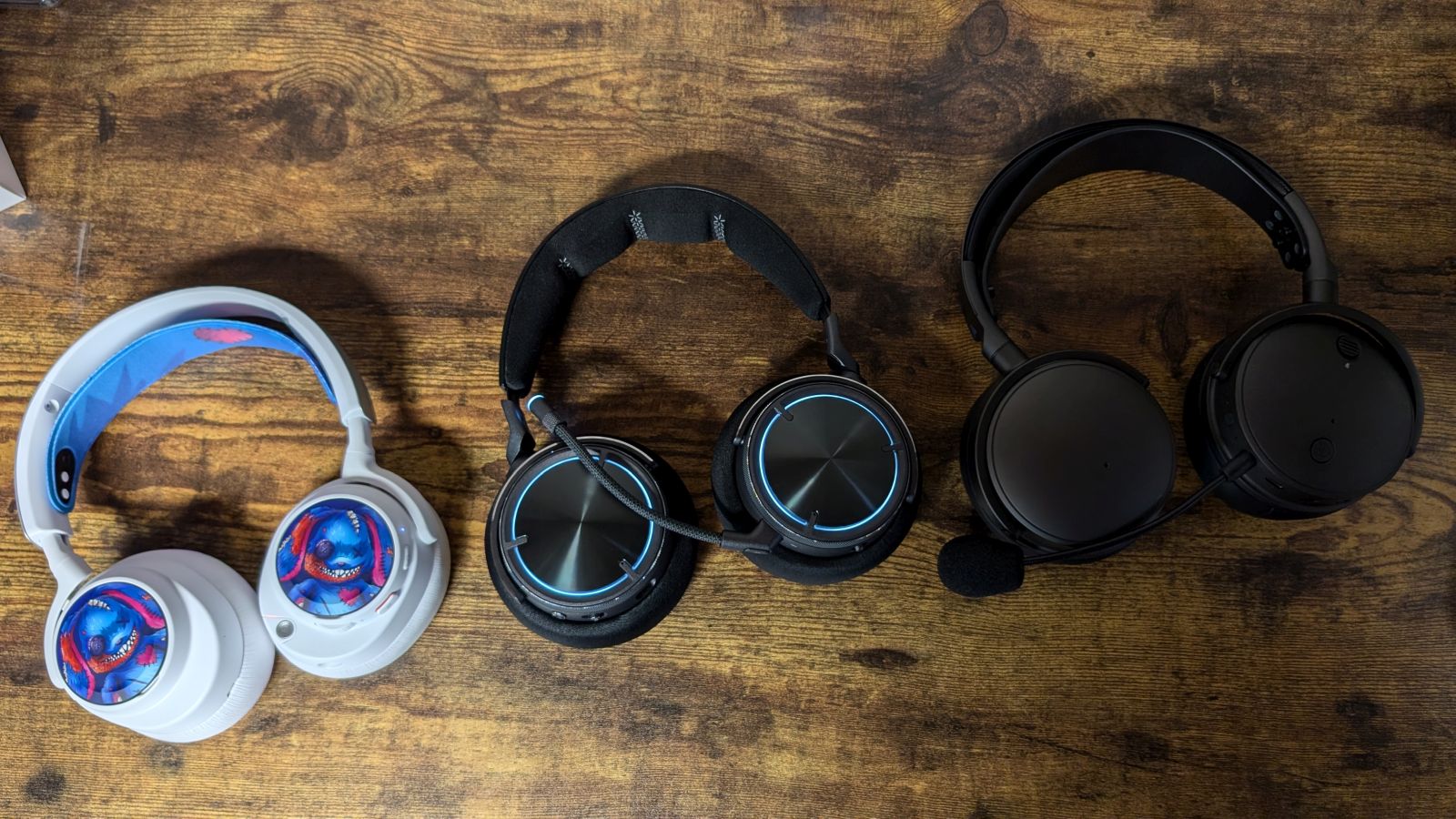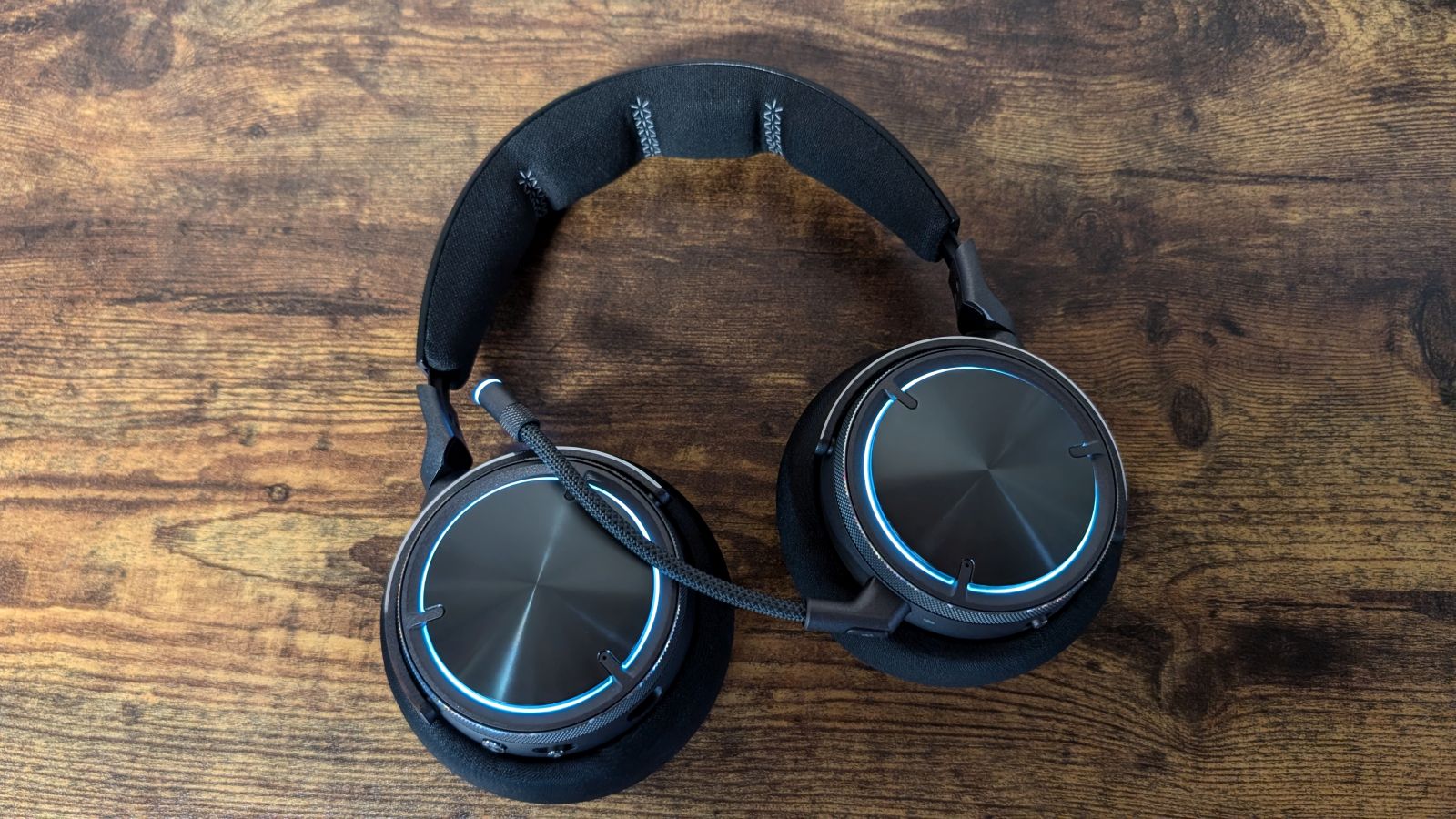
I’ve used a ton of headsets, many of which I’ve reviewed on this very website. As crazy as this journey has been, Corsair is a brand I’ve never picked up before. That is, until now. Corsair has released their heavy duty Virtuoso Max wireless gaming headset, and with the bevy of advertised features, I just had to get my hands on it. After testing it for quite some time, there are plenty of positives, although a couple of negatives as well.
Opening the box you’ll find the Virtuoso Max headset, detachable microphone, a USB dongle, and a USB-C charging cable inside a soft-shell carrying case. I’ve received cloth bags for taking my headset on the go with premium headsets before, but nothing as fancy as this carrying case. Certainly a good way to differentiate yourself from other products on the market while raising your profile. The USB-C cable is also a long, braided one, so the quality is on display for this headset.
Taking the Virtuoso Max out of the box and carrying case, you can tell this is a high-end headset. The aluminum build is very sturdy, although it is a bit heavy. I love the design, looking high-tech with sleek RGB lighting on the ear cups. The leather and memory foam headband has the aluminum and plastic skeleton inside, and the memory foam cushioning extends to the ear cups as well.
Once I put it on my head, I noticed the ear cup cushions are a bit large in circumference, so they can push on the outside of your head a bit along with heating up somewhat quickly. Similarly, the headband can get hot on your head after extended periods. Some of it may be the tight seal this headset forms around your ears, which is great for immersion but not as much for allowing the cushions to breathe. You’ll find yourself adjusting it occasionally to find the right fit, with periods of comfort in between.
On the Virtuoso Max are a few controls. I’m always a fan of integrating volume and game/chat balance wheels onto the ear cups, and these are of high quality with a textured metal wheel for an easy grip. The left ear cup has the power switch, which allows you to choose between only the USB dongle connection or adding in Bluetooth. A mute button on the detachable mic is also here. On the right ear cup is a mode/custom button, which has several features built into it via pressing or holding it. Besides the charging port, there’s a media switch on the Virtuoso Max, and I’m honestly not a fan. You can’t swap its functionality in software, and I’ve never found media controls on headsets useful, especially when the buttons are only for that capability.

While there is a QR code for a quick start guide revealed when you take the case out of the box, it’s a bit easy to miss. Given there are not as many controls and some have multiple functions, I’d like to see that guide a bit more prominently displayed. Maybe even including it as a paper guide as there are other warranty forms in the box. As soon as I used the guide it opened up the capabilities of the Virtuoso Max, showing exactly how much power is under the hood.
One of the biggest benefits of the Virtuoso Max is its versatility between devices. It features a USB dongle alongside Bluetooth. Just these two will allow you to connect your headset to almost anything. The dongle is different from other headsets, as I’ve usually had an additional dongle or switch I had to click to enable Xbox mode. On the Virtuoso Max, you simply press the mode button twice, and it swaps over to Xbox with the dongle’s Corsair logo now glowing green. It’s a fantastic design choice that makes using your headset easier than ever.
The Bluetooth is also a huge plus, as it’s simultaneous in nature meaning I can play a game while answering a call or listening to music at the same time. It also doesn’t take over your Bluetooth device’s volume in this state, so you can adjust it on its own. Never has it been easier to keep up with the game while playing Madden. Just don’t mix the two up.

I’m also quite impressed with the active noise cancellation of the Virtuoso Max. My wife is currently (at the time of this writing) watching a show upstairs, with the volume decently high so I can hear it down here at my desk. As soon as I activate ANC it’s all gone, even without turning on music or another audio source on my computer. I mentioned the tight seal the ear cups make over your ears, and this has to be to the benefit of the ANC. Also available is a transparency mode which uses your mic monitoring for the assist. Overall, this is a stellar mode that adds tremendous value to the headset.
Even though the sound you don’t hear is great, the sound you do hear could use some tuning. Don’t misconstrue that, as this is still a quality headset that offers detailed sound, but I think the uses are in question. Playing immersive games has been fantastic, and it functions especially well with a console, but I haven’t had the best spatial audio as I’ve played competitive games like Call of Duty. Dolby Atmos does come with the headset through the Dolby Access app, and I can tell this is what the team wants you to push your audio through – it’s a big boost to the sound quality. On its own however – which is how a lot of people are going to use the headset – it doesn’t have the same umph I expect that directs me via sound cues.
Although that drawback exists, I’m loving the range of the 50mm graphene drivers, which offer a fantastic blend of highs and lows, along with great bass. My music listening, when coupled with Dolby Atmos or SteelSeries Sonar EQ, really highlights the detailed audio available from this headset. It’s a shame that it takes outside tuning to make the sound quality shine its brightest.

Left to right comparison: SteelSeries Arctis Nova Pro, Corsair Virtuoso Max, Audeze Maxwell Wireless
Speaking of EQs, there are at least some built into the headset, and you can use Corsair’s ICUE app on PC to customize a few of your own ten-band profiles. It does feel like it’s the bare minimum however, and with Dolby Atmos available for free because of the headset on several of the supported devices you’ll use it with, I don’t see why you’d go with the stock option.
The detachable microphone mentioned before is one of the more intriguing parts of the Virtuoso Max. This omnidirectional mic plugs in via USB-C, and features a mute button at the bottom of the base. I think this is the best button placement I’ve seen on a headset for a mute function, and while flip-to-mute still reigns above all, being able to instantly know the location for the mute without reaching all over your ear cups is a terrific choice by Corsair. While that’s great, I’ve found the mic itself to be above average, peaking a bit too easily during my communication.

Battery life is outstanding on the Virtuoso Max. I haven’t charged them since pulling them out of the box, and with several long Black Ops 6 sessions behind me, I’m still at 40% of a charge. “Up to 60 hours” is what Corsair is selling, and that’s an easy box checked by the headset. When the battery life doesn’t cross my mind, it’s excellent.
Lastly, let’s touch on an odd technical issue. I’m not sure why, but when connected to my PC I’ve randomly had a few audio lag issues during Black Ops 6 play. It will slow what I’m hearing down, before getting a bit staticky or turning off completely. These issues have been sporadic, so this could be an interference problem. That said, since updating the headset it only happened once more, and my last long play session before writing these words yielded no repeat issue.
Corsair Virtuoso Max wireless gaming headset
Good
Even with a few odd issues and choices, the Corsair Virtuoso Max is a good headset that, with a few tweaks, becomes great. The drivers are capable of excellently detailed audio, ANC mode is phenomenal, and the battery lasts forever. If the comfort level can be raised along with the stock floor for the audio quality, this headset will be a player on the biggest stage.
Pros
- Sturdy and sleek premium build
- Versatility and simultaneous Bluetooth
- Phenomenal ANC
- Dolby Atmos included
- Some great 50mm drivers…
Cons
- …Which require outside EQ influence to get the best audio quality
- Not comfortable during long gaming sessions
